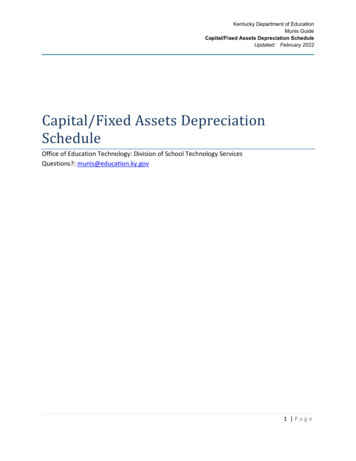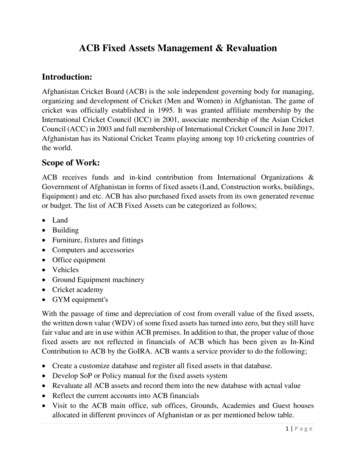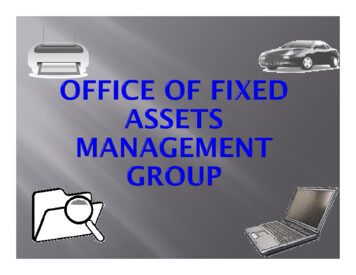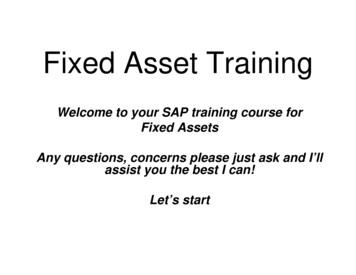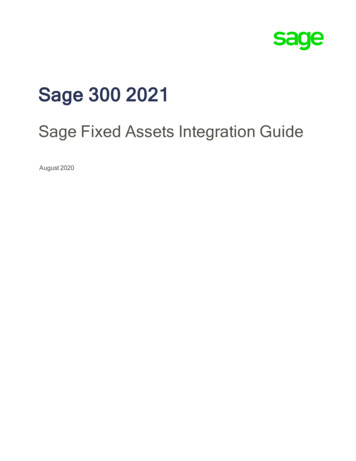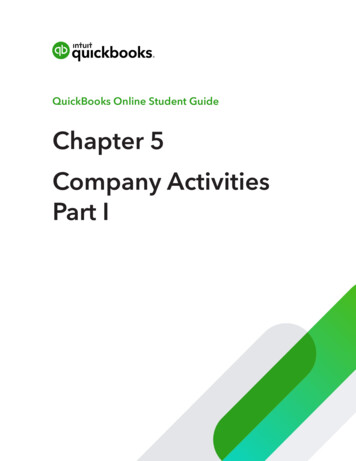
Transcription
Sage Fixed AssetsBest practices forfixed assetmanagersDeveloping solidtechniques forproper managementof fixed assets
Sage Fixed AssetsBest practices for fixed asset managersTable of contentsExecutive summary3Start with an accurate baselineEliminate “ghost” assetsConduct physical asset inventoriesTag assets appropriatelyUse the right labels for the jobSelect the right asset inventory hardwareChoose the best asset inventory software4445556Use the best tools for the jobMove away from error-prone spreadsheetsLook for a scalable solutionTake advantage of integration to other applicationsEffectively evaluate fixed asset management software77788Ensure accurate depreciation calculationsAchieve regulatory compliance1010Stop overpaying taxes and insuranceTake full advantage of fixed asset depreciation1111Save money using additional methodsMaximize the benefits of Section 179Don’t pay Alternative Minimum Tax if you don’t have toTime purchases to avoid midquarter12121212Create financial reports tailored to your businessUnderstand common fixed asset management reports1313Be knowledgeable about your fixed asset system15Supplement your solution when it makes sense16Sage Fixed Assets solutions put best practices into action!16Conclusion21This report is informational only and not meant as accounting, legal, or tax advice. Exceptionsand special provisions are not covered, so you should consult your accounting, legal, and taxprofessionals for advice specific to your situation.2
Sage Fixed AssetsBest practices for fixed asset managersExecutive summaryIn the world of accounting, the savings potential of improved fixed asset managementis often overlooked. It’s difficult to find the time and tools to devote the attention tofixed assets that they deserve. Yet assets like land, buildings, transportation, andmanufacturing equipment represent the largest investments most companies make.Sound fixed asset management can yield substantial tax savings in depreciationdeductions. Conversely, suboptimal fixed asset practices can threaten the accuracyof financial reports and negatively impact your bottom line. Establishing the higheststandards of depreciation accuracy and best practices in fixed asset managementwill pay off in savings and efficiency for: Corporate accountants managing fixed assets.CFOs striving to optimize business efficiencies and plan capital budgets.Government asset managers complying with GASB 34/35 standards.CPAs providing tax, depreciation, and auditing services to your clients.Nonprofit executives seeking to gain maximum leverage from alreadystrained resources.The goal of this paper is to help you learn about best practices for fixed assetmanagement and suggest tips for implementing them in your organization. These bestpractices will help you to seek potential savings in your fixed asset base and show youhow to save time in the process. The suggestions will guide you in how to: Establish an accurate baseline of fixed assets.Select the right tool for the job.Rely on accurate depreciation calculations.Stay up to date with legislative changes.Produce targeted financial reports.Get trained on the system you employ.Add modules or services when appropriate.“ One of the challengesfaced by fixed assetmanagers is knowingwhen assets arephysically transferredto another location,disposed, or sold.Sage Fixed Assetshas an automatedreconciliation processthat eases this processand readily integrateswith its accountingand depreciationfunctionality, providinga complete fixed assetmanagement solution.”Scott SwartsParagon SystemsIn the final section, you will be introduced to the Sage line of fixed asset solutions andlearn how these fixed asset management tools can build the foundation of your futurebest practices.3
Sage Fixed AssetsBest practices for fixed asset managersStart with anaccurate baselineThere is nothing more critical to effective management of fixed assets than beginningwith an accurate fixed asset inventory. Without it, no amount of added processes,controls, or correct calculations can ensure the accuracy of fixed asset accounting.The only reliable way to verify and validate the fixed asset information is to conduct aphysical inventory.Eliminate “ghost” assetsA “ghost” asset is property that is lost, stolen, or unusable but is still listed as anactive fixed asset in the system. According to Asset Management Resources, a leadingprovider of asset inventory and reconciliation services, “After 14 years of experience,AMR has repeatedly found that 65 percent of fixed asset data is incomplete,inaccurate, or altogether missing, while 10 percent to 30 percent of fixed assetsare no longer owned.”1To manage a profitablemust have informationregarding the currentlocation, use, state ofrepair, and futureusefulness of itsproductive assets. Thechief financial officerhas a duty to ensure asystem is in place toprovide this information.3Fixed assets hold a large presence on corporate balance sheets and represent thebulk of investments for many companies. If 10-30 percent of fixed assets on thebooks are ghost assets, a company might be overpaying taxes and insurance onthose assets by up to 30 percent. In addition to this negative impact to the bottomline, large inaccuracies in fixed asset reporting risks cause flaws in the overallaccuracy of corporate financials, posing a threat to executives responsible forensuring regulatory compliance.Ghost assets that are not identified can cause lost productivity because missing orunusable assets are not available when needed. Capital budgets are renderedinadequate because management is unaware of critical assets needing replacement.Conduct physical asset inventoriesIn order to support optimal management, fixed assets should be inventoried on aregular basis using a consistent method at every business location. The accountingdepartment and facilities department should work together to establish a system forconducting inventories as well as creating new assets in the fixed asset managementsystem upon purchase. In this way, both the facilities team and fixed asset accountingmanagers can be confident that ongoing operational procedures will result in the mostaccurate information possible in the companywide fixed asset management system.Physical inventories can be conducted concurrently at every location, referred toas “full inventory verification” or “wall-to-wall inventory.” Another method involvesconducting multiple partial inventories within different departments, possibly atdifferent times of year, known as “cyclical inventory verification.”2 The best methodfor each organization depends on factors like personnel and resources.Whether conducting a wall-to-wall inventory or partial inventories, all fixed assetinventory data should be centralized and reconciled against the existing data in thefixed asset accounting department. This ensures that fixed asset reporting providesmanagement with accurate assessments of the fixed asset picture across theorganization and ensures better compliance with regulatory requirements.1 Michael N. Day and Stephen Talbot, “Data Validation the Best Practice for Data Quality in Fixed AssetManagement,” (White Paper) Asset Management Resources, www.amrnow.com.2 William D. Brady, Jr., Managing Fixed Assets in the Public Sector: Managing for Service Excellence(Universal Publishers, 2001), 56-61.3 Raymond H. Peterson, “Accounting for Fixed Assets,” 2nd ed.4
Sage Fixed AssetsBest practices for fixed asset managersAnother method of establishing a comprehensive baseline inventory of fixed assets is toenlist the services of third-party asset management services. Outsourcing can ensurethat an initial wall-to-wall inventory is performed in an efficient, timely manner usingexternal personnel. For the purposes of regulatory compliance, it also providescompletely unbiased verification of assets. These service providers have demonstratedexpertise in useful related areas such as property tax strategy, cost segregation,insurance risk management, and valuation. Third-party providers can help implementfixed asset inventory software and hardware systems and train company staff toconduct future inventories.Tag assets appropriatelyWhen a company owns multiple fixed assets that are nearly identical, it can be veryeasy to make mistakes by creating duplicate asset records or failing to dispose of thecorrect asset when identical assets are retired. The easiest solution is to tag eachasset with a unique identifier in the form of bar code labels. This provides the additionaladvantage of speeding up the inventory process through the use of handheld technologythat can scan and record each bar code in seconds. Labels are an important aspect offixed asset management that is often overlooked. Due to environmental requirements,bar code necessities, and custom printing needs, you should look for a vendor thatoffers a variety of labels that can be printed on demand to meet your specifications.Use the right labels for the jobChoosing the type of bar code labels for assets depends on an assessment of the typeof assets to be labeled as well as the environment in which the assets operate. Manytypes of high-quality, durable preprinted labels are available. Outdoor assets willrequire labels that withstand temperature variations as well as exposure to water. Forhigh visibility, foil labels stand out and are easy to read. You may wish to purchaselabels that break when removal is attempted to prevent labels from being tamperedwith or moved to another asset. Machinery and equipment in some operatingenvironments need unique labels that can endure extremely high temperatures,such as 250 and up. Some samples of specific label types include the following: “ Sage Fixed Assets issuch a versatileproduct, we were ableto perform a dynamicinventory of all thehospital’s existingassets with handheldscanners, reconcile thatcount, and establishpolicies and proceduresfor future fixed assettagging in a matterof months.”Suzanne Pedone, PresidentIMSolutions.netBar coding of individualasset tags will significantlyreduce the effortsnecessary for inventories.4Tamper EvidentFoilPolyesterDestructible VinylSelect the right asset inventory hardwareOnce the decision is made to identify fixed assets using bar code labels, the inventoryprocess will benefit greatly from the speed and efficiency gained through bar codescanning devices. Hardware should be selected to meet the needs of your business,and there are many types of hand-held devices available. In addition to traditional barcode scanners, a variety of PDAs and Pocket PCs support bar code scanning.Each type of bar code hardware has distinct advantages. Dedicated bar code scannersare extremely durable, reliable, and efficient. They scan faster and with greater accuracyon the first try than any other type of hardware. PDAs and Pocket PC devices are lesscostly and can be used for a variety of functions. These multiuse devices also supportemail, address books, notepads, and other personal applications in addition to barcode scanning and inventory software.4 Raymond H. Peterson, “Accounting for Fixed Assets,” 2nd ed.5
Sage Fixed AssetsBest practices for fixed asset managersChoose hardware that is effective for your business based on: Number of fixed assets to be inventoriedNumber of inventories conducted annuallyConditions under which inventories are conductedOther uses you may expect from the bar code reader devicesAvailable hardware budgetChoose the best asset inventory softwareWhen added to your fixed asset depreciation software, an integrated fixed asset inventorysolution will save time through automatic reconciliation of the latest inventory data.Such software dramatically reduces errors because inventory data does not have to bemanually reentered into the fixed asset accounting system. For the inventory solutionto be effective, it should easily integrate into your existing fixed asset depreciationsoftware and your general ledger system.Procedures should besuch that if expensiveequipment is removed,it will be missed withina reasonable time, andsome record will existas to who had accessduring that period.5When selecting a fixed asset inventory solution, make certain that the packagesupports a variety of hardware choices that are cost effective for your business.Inventory software should have the ability to support both baseline inventories to addnew assets and dynamic inventories to update and verify data on existing assets. Ifyour company has multiple locations, you’ll want the software to provide the ability toconduct concurrent inventories while centralizing the results. Other selection criteriamight include the ability to create groups and lists for identification during property taxpreparation and a check-in/check-out feature that creates a history trail to prevent lossor theft of mobile assets.Solutions for best practices: Sage Fixed Assets—Tracking Enables multiple concurrent inventories with centralized reconciliation Check in/check out feature monitors assets on the move Seamlessly integrated with Sage Fixed Assets—Depreciation“ When we first implemented Sage Fixed Assets, the accounting staff conducteda full-blown audit, tagging all of the company’s assets. Now, each location canperform its own inventory with hand-held scanners, and we’ve significantlyreduced our travel expenses.”Ryan Schipper, Endries International, senior accountantMore details about these benefits and more in the Sage Fixed Assetssolutions section.5 Raymond H. Peterson, “Accounting for Fixed Assets,” 2nd ed. (New York: John Wiley and Sons, 2002), 65.6
Sage Fixed AssetsBest practices for fixed asset managersUse the best toolsfor the jobThe stakes are too high to risk significant errors in fixed asset accounting. Fixedasset managers require an organized, consistent system to manage fixed assetsthat yields reliable, accurate depreciation results. Fixed asset management softwareprovides fixed asset managers with the tools they need to optimize the quality of fixedasset management and support executives in making sound decisions about fixedasset priorities. he simple use of a systemTthoroughly designed fordepreciation, versuswriting your own inside aspreadsheet program, isa tremendous timesaver.7Move away from error-prone spreadsheetsMany fixed asset managers attempt to calculate depreciation using spreadsheets thatthey must program and update manually. Creating depreciation spreadsheets requiresa tremendous expenditure of time, and they are prone to many problems, including: Errors in formulae that go unnoticed and cause miscalculations.Changes in tax rules and regulations that do not get incorporated.Lack of audit trails and history.Inability to change depreciation methods for an asset easily.Limited internal control features to comply with Section 404 of Sarbanes-Oxley.Difficulty in exchanging data with other accounting applications.Inability to attach other information (such as images) to an asset.Failure to integrate with an inventory solution.“Spreadsheets can certainly perform complex mathematical calculations. They are,however, not the best tool for managing fixed assets,” cautions former editor ofAccounting Technology, Ted Needleman, advising instead, “What your clients needis a combination of database and calculation engine.”6Sage Fixed Assets—Depreciation contains over 300,000 IRS tax and GAAP rules andover 50 methods of depreciation—and this is just an example of what is entailed indeveloping a depreciation calculation engine. Simply put, the spreadsheet method forcalculating depreciation on fixed assets is too difficult, risky, and time consuming to beconsidered effective.Look for a scalable solutionWhen selecting fixed asset software, consider the size of your organization and thenumber of fixed assets as well as potential for future growth. When you choose asolution provider, ask about the scalability of the software you are evaluating. If yourbusiness is small, ask if the provider offers a version of the software designed for theneeds of small businesses and available at a more affordable price. This will ensurethat you can optimize your fixed asset management while maintaining a positive returnon investment. If your business is midsized or larger, can you add integrated productsfor additional functionality, such as inventory management, project accounting, andadvanced reporting? When considering inventory solutions, be sure that the solutionwill be able to accommodate evolving needs in your choices of barcode readerhardware and labels. As your company acquires more assets, are faster, more powerfulsolutions available to meet the needs of an expanding fixed asset database? Is thereporting package extensive and easily customizable, based on your organization’schanging needs?6 Ted Needleman, “Fixed assets software: The forgotten application?” Accounting Today, October 11, 2004.7 Wayne Schulz, “Fixed asset software: More than just depreciation,” Accounting Today, October 6, 2003.7
Sage Fixed AssetsBest practices for fixed asset managersTake advantage of integration to other applicationsTo reduce the risk of needless error and make the best use of your time, it is essentialthat the fixed asset management system you select integrates with your accountingsystem. All fixed asset management modules should integrate seamlessly together andreconcile within one centralized database. Additionally, your fixed asset system shouldbe able to exchange data with your general ledger and other accounting systems.Whenever data can be automatically shared between applications, valuable time issaved that would otherwise be spent manually rekeying critical data. Integration alsoensures that clerical errors, such as typos, do not cost your organization money andcompromise accuracy.Effectively evaluate fixed asset management softwareFortunately, fixed asset management software solutions exist that can automate theprocess while saving time and eliminating the errors associated with spreadsheets. Inreviewing fixed asset software packages for the CPA Technology Advisor, Isaac O’Bannonrecommends examining navigation and ease of use, management features, integration,reporting abilities, and the quality of technical support and software updates.8 Thefollowing are some features and considerations in each of these areas of fixed assetsoftware evaluation:Navigationandease of use User interface should display multiple books on the same screen forcomparison. Templates reduce data entry errors and save time during the creationof new assets. Simplified processes for initial installation and setup of company data. Importing existing data from your current solution or spreadsheetshould be easy. Help and documentation features should be comprehensive andeasy to use.Managementfeatures Choose a solution that allows you to customize fields and define atleast one book to the specific needs of your organization. The ability to add images to an asset file allows you to storephotographs of an asset, purchase receipts, and more. Solutions that raise flags for further review can help you avoidan IRS audit. Query or grouping features enable you to search for, define, and editmultiple assets quickly. Make sure you can print appropriate fixed asset-related tax formsdirectly from your solution to avoid unnecessary rekeying ofdepreciation data.Integration Fixed asset solutions should be open and extensible, enabling the freeflow of data both into and out of the fixed asset management systemthrough reports and external files. Integration with general ledger software saves time and reducesclerical errors by eliminating duplicate data entry. Integration with an inventory solution automates verification andreconciliation of fixed assets. Security features are essential to safeguard the accuracy ofdepreciation data. Gain remote access to the fixed asset solution in a way that is secureand easy to implement. Citrix, Windows Terminal Services, and VirtualPrivate Networks can provide reliable access from remote locationswithout compromising data control.8 Isaac M. O’Bannon, “Forecasting Capabilities Aid in Long-Term Depreciation Strategies:A Review of Fixed Asset Software,” The CPA Technology Advisor, November 2004.8
Sage Fixed AssetsBest practices for fixed asset managersReporting A solid variety of prebuilt reports enables the fixed asset manager andfinancial executives to review most standard asset metrics quickly andregularly. The ability to customize standard reports provides fast, easyformatting to your business preferences. Select a vendor that provides a custom report-writing tool if you willneed to create additional reports without learning a complex reportingtool or being a database administrator.Technicalsupport/updates Select a software vendor that demonstrates a long history ofleadership in fixed asset management. Seek feedback on both the product and the company. Look for demonstrated commitment to and leadership in technicalsupport as well as easy access to support when you require it. Regular software updates accommodating tax law changes should beprovided with the technical support plan. Vendor should provide a solution that fits your business model—nonprofits and government entities manage fixed assets differentlyfrom corporations. rocedures should bePsuch that if expensiveequipment is removed,it will be missed withina reasonable time, andsome record will existas to who had accessduring that period.9Carefully review both providers and solutions as you conduct your evaluation. Find outhow other customers are benefiting from the solution. Ask for a demonstration or tryout an evaluation copy at your company. By beginning your search for a solution with aclear idea of the features you would find most beneficial and selecting from vendorsthat have a long history and expertise, you’ll ensure that you find the software that isright for your organization.Solutions for best practices: Sage Fixed AssetsSage Fixed Assets solutions offer a range of applications for accurate fixed assetaccounting and depreciation based on the size of your business and your type oforganization. Sage Fixed Assets—Lite Depreciation—designed for small businesses withfewer than 1,000 assets Sage Fixed Assets—Depreciation—for medium-sized firms Sage Fixed Assets—Premier Depreciation—delivers increased speed andcapacity for midsized to large companies Sage Fixed Assets—Planning—allows for easy management of projects duringthe construction of fixed assets Sage Fixed Assets Gov Solutions—specially designed for the GASB 34/35needs of governmental entities Sage Fixed Assets Nonprofit Solutions—designed to help nonprofitorganizations fully leverage their fixed assets“ Our portfolio is twice the size it was in 1995—people don’t realize the level ofcapital investment we continue to make. Sage Fixed Assets has allowed us togrow without increasing our staff and audit fees proportionally.”Jonathan Levi, VP of IT & Telecommunications, The Mills CorporationFind out which is right for your organization in the Sage Fixed Assetssolutions section.9 Raymond H. Peterson, “Accounting for Fixed Assets,” 2nd ed. (New York: John Wiley and Sons, 2002), 65.9
Sage Fixed AssetsBest practices for fixed asset managersEnsure accuratedepreciation calculationsThe most important function of fixed asset management is to ensure that depreciationis calculated correctly for all fixed assets. Fixed assets represent the majority of capitalinvestments for most companies and can account for 35-50 percent of Fortune 500companies’ total assets.10 With this much at stake, it is imperative that fixed assets aremanaged with solid procedures, best practices, and optimal technology.Fixed asset depreciation mistakes are costly. Because fixed assets represent such asignificant investment for most companies, mistakes in fixed asset management canhave negative consequences. Depreciation errors can result in financial reportingmistakes, risking failure to comply with regulatory requirements. Improperly calculateddepreciation can also be expensive to the company both through the overpayment ofproperty taxes and insurance and failing to take maximum advantage of depreciationmethods that result in larger tax savings.Achieve regulatory complianceWhen Congress passed the Sarbanes-Oxley Act in 2002, it sought to improve corporategovernance of public corporations and reduce fraudulent reporting. The Act placesnew financial reporting burdens on corporations and imposes strict penalties fornoncompliance. CEOs and CFOs of public U.S. companies must personally certifythe integrity of financial reports, as well as the procedures and systems used to createthem. Public accounting firms must affirm the validity of the financial reportsand assessments.Although Sarbanes-Oxley currently applies only to public companies, many privatecompanies and nonprofits are also adopting the methods in an effort to provide betterfinancial insight to financial partners, boards, and donors.Section 404 of this act requires a corporation to report on the effectiveness of itsinternal controls and requires an external auditor to attest to this statement.Consequently, corporations must now document their internal control structureand evaluate its effectiveness to ensure the accuracy of financial data. By havingan outside software vendor provide a packaged fixed asset solution, a companydemonstrates that it is not creating its own unique depreciation calculations outsideof the scope of current legislation and IRS tax rules.Compiling an accurate financial picture of a company requires accurate fixed assetrecords as well as compliance with applicable tax laws and regulations for acquiring,depreciating, and disposing of assets. Fixed assets represent so much of a company’sinvestments that errors in depreciation can have an impact on the accuracy of thelarger financial picture. Faulty corporate financial reports can form the basis forcriminal liability for both executives and auditing firms under Sarbanes-Oxley.10 Jennifer Kruger, “Fixed Asset Fix,” CFO Magazine, February 1, 1999.10
Sage Fixed AssetsBest practices for fixed asset managersStop overpaying taxesand insuranceIf assets that are no longer in service are not properly disposed of in accountingrecords, companies can continue to pay property taxes and insurance on them.Companies are, on average, overpaying taxes and insurance on approximately 12percent of the fixed assets on the books. Even mistakes in the amount of depreciationcalculated can result in overpayment, as insurance premiums are usually based on apercentage of the total current value of fixed assets.As you consider fixed asset management software, it’s helpful to determine the returnon investment (ROI) that optimized fixed asset management would provide yourcompany. To calculate ROI, you’ll look at the total value of your fixed assets andestimate the amount of lost or stolen assets on your books. The average for mostcompanies is about 12 percent. Then, based on your tax and insurance rates, calculatethe value of overpayments on taxes and insurance for your ghost assets. Compare thisannual expenditure to the cost of purchasing and maintaining support on a fixed assetmanagement system. depreciationAdeduction has beena part of modern U.S.income tax since itsinception. It is at thenexus of several taxpolicy objectives thatat times competeagainst and at othertimes complementone another.11Following is an example of the effects of 12 percent overpayment of federal and stateincome tax, personal property tax, and insurance:Number of fixed assets500Total cost of depreciable fixed assets 2,000,000Average value of each asset 4,000Percentage of ghost assets12%Total cost of ghost assets 240,000Tax rate—Federal and state36% on 40% avg. remaining asset lifeTax rate—Federal and state3.4% on 70% of assetsPersonal property tax3.4% on 70% of assetsInsurance rate1 cent per 1Potential overpayment—Federal and state 34,560Potential overpayment—personal property tax 5,712Potential overpayment—insurance 2,400Total potential annual overpayments 42,672For a tool that helps you calculate your own organization’s ROI in fixed asset software,visit www.SageFixedAssets.com/ROI and enter estimates of asset value and numberof assets.Take full advantage of fixed asset depreciationFixed assets are expensive to purchase and maintain, so it is fortunate they alsorepresent tax savings in the form of depreciation write-offs. But tax laws are constantlychanging, and it takes extra vigilance to ensure that each asset is assigned the correct11 Beth B. Kern, “Accounting Historians Journal,” The role of depreciation and the investment tax credit in tax policy and their influenceon financial reporting in the 20th century, Accounting Historians Journal, December 2000, p 1.11
Sage Fixed AssetsBest practices for fixed asset managersuseful life, depreciation method, and any additional bonus depreciation amounts inorder to maximize tax savings. In the past, special 30 percent and 50 percent bonusdepreciation represented significant tax incentive for certain types of fixed assetpurchases. Additionally, the limits for Section 179 expenses (allowing for the fulldepreciation of an asset within the first year of purchase) have increased several timesin recent years. Failing to take the full depreciation available on a fixed asset is anopportunity lost and provides additional impetus for companies to demand accuratedepreciation calculations.Save money usingadditional methodsBelow are additional ways you can use best practices for fixed asset management tosave your organization money and help deliver more to the bottom line.Maximize the benefits of Section 179Usually, you must capitalize and write off the cost of long-lived business property overa period of years.The Section 179 provision lets you immediately exp
In the final section, you will be introduced to the Sage line of fixed asset solutions and learn how these fixed asset management tools can build the foundation of your future best practices. "One of the challenges faced by fixed asset managers is knowing when assets are physically transferred to another location, disposed, or sold.
